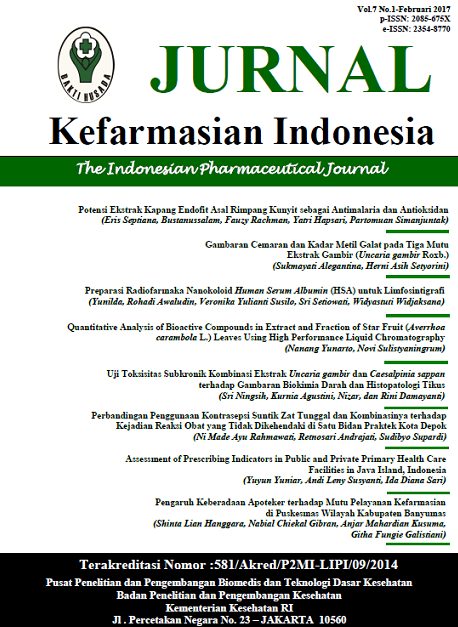Gambaran Cemaran dan Kadar Metil Galat pada Tiga Mutu Ekstrak Gambir (Uncaria gambir Roxb.)
Abstract
Gambir (Uncaria gambirRoxb) is a plant that has many benefits to health such as antioxidants, antihiperlipidemiaandantibacterial. Gambir extract derived from the leaves and twigs of Uncaria gambirRoxb through the process of removing the sap by being boiled, squeezed / compressed, liquid is deposited, molded and dried. During the plant grows, then harvest, process, stored and distributed, it is might contaminated with microbes or chemicals. Based on the requirement issued by BPOM No. 12, 2014 about Traditional Medicine Quality Requirements, it requires us to test the extract that we will use. To determine the contaminant of all three gambir extracts, we tested against yeast fungi figures, total plate count, aflatoxin and heavy metals. Besides that, we also determine content of active compound of methyl gallate which has benefits as an antioxidant with a densitometer. the result shows, there werecontaminants that exceeded the requirements. Contaminants that exceeds the requirement are number of fungi yeasts (7,5.10-6) and aflatoxin G2 (47,38.106ppb) in gambier extract quality 3. The highest content of active compound of methyl gallate was obtained from extracts of gambir quality 3 (2.30%) followed by gambir quality 2 (0.44%) and gambir quality1 (0.14%).References
Nitha TG, Jayanthi J, Ragunathan MG. Antioxidant activity, total phenol, flavonoid, alkaloid, tannin, and saponin contents of leaf extracts of Salvinia molesta. Asian Journal of Pharmaceutical and Clinical Research. 2016;9(1):200-3.
Taniguchi S, Kuroda K, Doi K, Yoneda Y, Tanabe M, dan Shibata T et al. Evaluation of gambir quality based on quantitative analysis of polyphenolic constituents. Yakugaku Zasshi The Pharmaceutical
Society of Japan. 2007;127(8):1291-300.
Djanun L. Peluang Ekspor Gambir di Pasar Internasional. BPEN Depperindak Jakarta. 1998;
Amos A. Kandungan katekin gambir sentra produksi di Indonesia. J Stand. 2010;12(3):149–55.
Yunarto N, Elya B , Konadi L. Potensi fraksi etil asetat ekstrak daun gambir (Uncaria gambir roxb.) sebagai antihiperlipidemia. Jurnal Kefarmasian Indonesia. 2015;5(1):1-10.
Yunarto N, Aini N. Effect of purified gambir leaves extract to prevent atherosclerosis in rats. Health Science Journal of Indonesia. 2015;6(2):105-10.
Pambayun R, Gardjito R, Sudarmadji M dan KK. Kandungan fenol dan sifat antibakteri dari berbagai jenis ekstrak produk gambir (Uncaria gambir Roxb). Majalah Farmasi Indonesia. 2007;18(3):141–6.
Sulistyaningrum N, Rustanti L, Alegantina S. Uji mutagenik ames melengkapi data keamaanan ekstrak gambir (Uncaria Gambir Roxb.) Jurnal Kefarmasian Indonesia. 2013;3(1):36-45
Isnawati A, Raini M, Sampurno OD, Mutiatikum D, Widowati L, Gitawati R. Karakterisasi tiga jenis ekstrak gambir (Uncaria gambir Roxb) dari Sumatera Barat. Buletin Penelitian Kesehatan.2012;40(4): 201-8.
Angele N, Tchana, Paul F, Moundipa, and Tchouanguep FM. Aflatoxin contamination in food and body fluids in relation to malnutrition and cancer status in Cameroon. Int. J. Environ. Res. Public Health. 2010;7:178-188
Liu C, Zhang Y, Zhang F, Zhang S, Yin M, Ye H, et.al.Assessing pollutions of soil and plant by municipal waste dump. Environ. Geol., 2007; 52:641-51.
Fatoba PO, Udoh F, Emem G. Effects of some heavy metals on chlorophyll accumulation in Barbula lambarenensis. Ethnobotanical Leaflets. 2008;12:776-83.
Menteri Hukum dan Hak Asasi Manusia Republik Indonesia. Peraturan Kepala Badan Pengawas Obat dan Makanan Republik Indonesia Nomor 12 tahun 2014 tentang Persyaratan Mutu Obat Tradisional. Badan Pengawas Obat dan Makanan Republik Indonesia. 25 Agustus 2014
Rodriguez-Amaya DB, Sabino M. Mycotoxin research in Brazil: The last decade in review. Brazilian Journal of Microbiology. 2002;33:1–11.
Taufik M, Prasada E, Nurdin H, Ibrahim S, Dachriyanus. Antioxidant activity of methyl gallate isolated from the leaves of Toona sureni. Indo.J.Chem. 2009:(3); 457-60.
Kamatham S, Naresh K. Isolation and characterization of gallic acid and methyl gallate from the seed coats of Givotia rottleriformis Griff and their antiproliferative effect on human epidermoid carcinoma A431 cells. Toxicol Reports. 2015;2:520–9.
Afsari T, Janeen H, Trembley WE, Christine E, Salomon E, Razak S, et.al. Growth inhibition and apoptosis in cancer cells induced by polyphenolic compounds of Acacia hydaspica: Involvement of multiple signal transduction pathways. Scientific reports. 2016;6(23077):1-12
Kasture VS, Katti SA, Mahajan D, Wagh R, Mohan KS. Antioxidant and antiparkinson activity of gallic acid derivatives.Pharmacology online. 2009;1:385–95.
Departemen Kesehatan RI. Parameter Standar Umum Ekstrak Tumbuhan Obat. Direktorat Jenderal Obat dan Pengawasan Makanan.2000
Gumbira SE, Syamsu K, Mardliyati E, Herryandie A, Evalia NA, Rahayu DL, et.al 2009. Agroindustri dan Bisnis Gambir Indonesia. IPB Press, Bogor
Badan Standardisasi Nasional (BSN) melalui SNI 01-3391-2000
Departemen Kesehatan Indonesia. Farmakope Herbal Indonesia. Edisi I. Jakarta. 2008
Peraturan Kepala Badan Pengawas Obat dan Makanan Republik Indonesia No. 12 tahun 2014. Persyaratan Obat Tradisional. Badan Pengawas Obat dan Makanan.
Bokhari FM. Spices mycobiota and mycotoxins available in Saudi Arabia and their abilities to inhibit growth of some toxigenic fungi. Mycobiology. 2007;35 (2):47–53
Ezekwesili-Ofili JO, Onyemelukwe NF, Agwaga P, Orji, The bioload and aflatoxi
Copyright (c) 2017 Jurnal Kefarmasian Indonesia

This work is licensed under a Creative Commons Attribution-NonCommercial-ShareAlike 4.0 International License.














